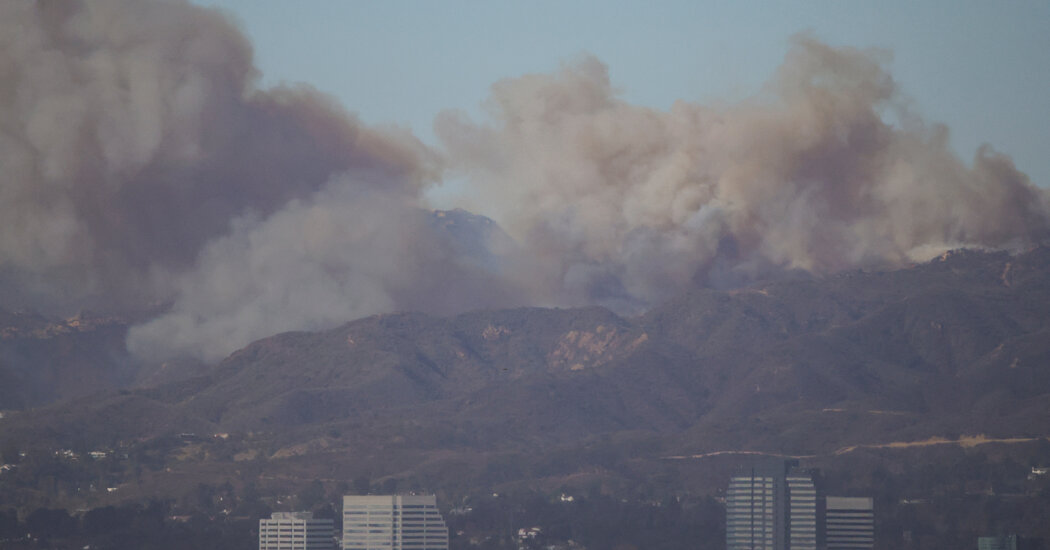The Santa Anas Fires: Rare Phenomena in Southern California, and the First of the Palisades and Eaton Fires
Experts say the winds are particularly violent and destructive during the Santa Anas, which are a normal part of life in southern California.
The winds may return next week. “We’re not catching a break,” Mr. Thompson said. “There’s just no rain in the forecast. This is going to be an ongoing issue in the next few weeks.
The utility companies that serve the region warned of the possibility of shutting off power in anticipation, but so far none have done so. The San Diego Gas and Electric Company is considering shutting down power for tens of thousands of customers on Tuesday. Southern California Edison said it was considering cutting off nearly 400,000 customers, one of its largest pre-emptive outages ever.
A rare “particularly dangerous situation” red flag warning was issued for portions of Ventura, Los Angeles and Orange counties, including downtown Los Angeles, for Tuesday and Wednesday. It is the third time this season that forecasters have issued this level of warning; the previous two warnings came during conditions that led to the Mountain and Franklin wildfires. Such warnings are very rare. For warnings in 2020, the Los Angeles office of the National Weather Service issued them only twice before this year.
The brush fire in the Santa Monica Mountains was caused by a 60 mph winds that caused it to explode in size. These gusty winds — which haven’t even reached the maximum predicted 80-100 mph yet — make firefighting difficult, picking up embers and dropping them up to 3/4 of a mile beyond the fire line.
The two largest blazes — the Palisades and Eaton Fires — have consumed more than 10,000 acres each and prompted mandatory evacuations for almost 70,000 people as of Wednesday. 58,000 people have been warned to be prepared to leave.
What are the Santa Ana Winds and How Are They Impacting the LA Wildfires? Source: Mike Wofford, NWS Director, Oxnard, Calif.
Mike Wofford, a lead forecaster at the National Weather Service’s office in Oxnard, Calif., says the Santa Ana winds are most common during the cooler months from September through May. They are caused by high pressure in the southwestern United States that pushes through the mountain passages in Southern California towards a lower pressure area off the coast.
The high pressure that develops above that area creates a strong flow of air that comes out of Nevada and hits us in the San Gabriel Mountains and Inland Empire.
The key characteristic is that the winds are what’s known as katabatic, meaning they flow downhill, says Mingfang Ting, a professor at Columbia University’s Climate School.
As the air mass drops in altitude, it begins to warm up by 10 degrees Celsius per kilometer. She says that it’s a very effective way of warming up the air.
She says the air warms up and decreases its humidity. It can travel through narrow mountain passes in the same way that air can travel through a tunnel or the wind can travel between buildings.
The result is wind gusts as high as 100 mph in some places, he says, adding that the current dry conditions mean, “everything is just primed and ready to go” for wildfires.
We have a lot of cars in the area. If one breaks down, overheats and someone pulls over next to an area where there’s some dry brush, that can kick it off,” he says.
Source: What are the Santa Ana winds and how are they impacting the LA wildfires?
Climate Change and Wildfires: The Los Angeles Area Adapted to a Wet, Wet Climate from 2023 Towards Spring 2024
Park Williams, a professor of geography at UCLA who heads the hyFiVeS Research Group describes the current scenario as a “highly improbable sequence of extreme climate and weather events over the past two years.”
It’s not just the dry weather this year, he says, but “from winter 2023 through spring 2024, the Los Angeles area experienced an exceptionally wet climate and this led to the growth of an extraordinary amount of new vegetation biomass in the hills and mountains surrounding the city.”
What role might climate change play? Climate change is known to cause the rapid spread of wildfires.
